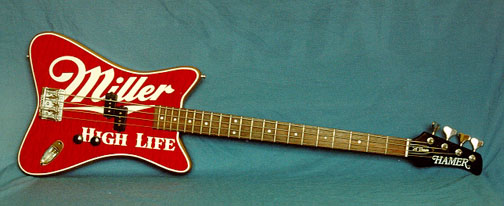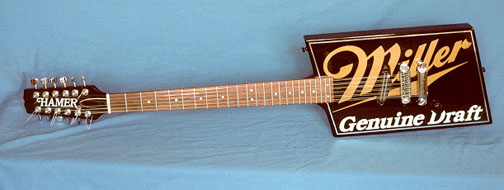
The later type of Miller Music six-string with a six-on-a-side headstock.
The first instruments to be made were the red and gold ‘Miller Music’ six string guitars. These were essentially the same shape as the Miller Beer bottle label (i.e.:- butterfly shape) but Jol Dantzig redesigned the shape to be slightly asymmetrical to make it function as a guitar and to make the instruments balance better. These guitars appeared
in 1985 and had a somewhat unusual finish; the entire reverse of the guitar was a metallic gold finish, but the face was flame maple finished in transparent cherry with a white border (painted rather than created with plastic binding). A large white graphic of ‘Miller Music’ decorated the front of the guitar. It is hard to imagine why these guitars often have spectacular flame tops rather than Hamer taking the easy option if simply finishing the top in opaque red paint. They were fitted with two Hamer humbuckers, a Sustain-block bridge, one volume, one tone and a three-way selector switch. The early versions of them had a three-a-side headstock, much like the contemporary Floyd Rose Special. In keeping with Hamer models at the time the neck had 22 frets. The most famous recipient of one of these guitars was Rick Nielsen, and his #513811 can be seen in the book of his collection (Guitars of the Stars vol.1).
However, soon after beginning the contract for Miller the three-a-side headstock was replaced with the now virtually ubiquitous six-on-a-side headstock, as found on most 1985 models (Steve Stevens, Phantom, Scarab, FBI, TLE), the fret count remaining at 22.
It would be unfair for only the guitarist to benefit by receiving a Hamer, so pretty soon a few basses similar in design to the guitars was conceived. These shared the butterfly shape and the finish colors, but carried the legend ‘Miller High Life’. They had pretty much standard Hamer features, such as a sustain-block bridge, a single P-type pickup (by DiMarzio), one volume, one tone, front mounted jack and the common headstock design used on most Hamer basses at that time. Curiously, out of all the Miller Guitars I have seen, only the Miller Music design carries the small R denoting a registered trademark .
Frank Untermyer at Hamer estimates that they perhaps made about one hundred of these instruments, which actually makes them quite common. They were replaced in 1987 by a new design, which was perhaps even more radical.

A Miller High Life Bass from early 1986. This bass carries the legend ‘A-Train’ on the truss rod cover, which was the Miller sponsored band that this bass was originally made for. The matching ‘A-Train’ guitar is believed to currently belong to Peter Green.
Miller Guitars – The Next Generation

A 1987 Genuine Draft bass. Note the basic layout and the standard Hamer bass headstock. The silver inlaid border can be clearly seen.
The red and gold Miller guitars were replaced in 1987 by a new design based on the Miller Genuine Draft label and logo. The body shape is rhomboid, but not a slavish copy of the bottle label. Jol Dantzig actually put some thought into the design and the result was a body shape that was angular but reasonably practical. Perhaps the only criticism is the basses do tend to be neck heavy because of the small body size. These instruments were finished in an all over opaque black with a copper coloured Miller logo on the front, the legend ‘Genuine Draft’ below in white. The most striking feature must be the silver border to the design. This is not painted but is a strip of thin metal inlaid into the guitar face, which is certainly an incongruously detailed feature for what some may see as a purely promotional item.
Hardware for the six string guitars was in keeping with the models then in their range – sustain block bridge or Floyd Rose trem., humbucker at the bridge position, a single coil at the neck. The bass was also pretty standard with a single P-type pickup and sustain block bridge.

l/h twelve string. An example of how Hamer made the effort to cater to the needs of players rather than see these guitars as purely promotional gimmick pieces.
The players were directly in contact with Hamer and, although they were commissioned by Miller, the players themselves could ask for particular features. The result of this are some odd combinations. Unfortunately, most of the players that these guitars were made for were not really interested in them, so oddballs aren’t so common. One such special request is shown below, a left-handed twelve string with a single OBL pickup. The original recipient is unknown. There may be several other such guitars out there, let me know if you have one.
There were clearly fewer of these Genuine Draft instruments. My information, which not official, is that there are twelve basses and twenty-five to thirty guitars including one offs, so these are rarer than the butterfly shape instruments. However, they do seem to be less desirable because of their less ergonomic styling.
The Miller guitars are all made to Hamer’s usual high standards, out of top grade materials. As mentioned above many of the red and gold guitars have beautiful flame tops although they are mostly obscured by the graphic. No compromise is made on playability and all these instruments perform as well and sound as good as any other Hamer. It is unfortunate that few people have seen beyond the outlandish shapes and original promotional intentions; they have failed to appreciate just how original and unique the Miller guitars really are.

photo courtesy of Steve Matthes
Postscript

The Miller Genuine Draft instruments (guitars and basses) hanging up to dry in the factory in 1987 after the graphics had been applied (courtesy of Steve Matthes).
Jol Dantzig and Hamer were less than enthusiastic about the Miller guitars. In fact, in an e-mail to me Jol actually described the project as ’embarrassing’. The one advantage (other than the business) to the project was that Hamer made contact with the emerging artists in the Miller programme. However, something happened to change his view on these ‘gimmicky’ Hamers.
He has always been a great fan of Peter Green, who left the music business in the seventies because of health problems. Recently, Peter Green’s health has improved sufficiently for him to make something of a low key comeback. On the lookout for new instruments to tour with, he found and bought a Miller Music guitar for sale in a store in Newcastle-upon-Tyne, England. In September of 1998 Jol had a chance to spend some time with Peter Green and was surprised to find that his current favorite guitar is a Miller Music six string (the partner to the bass shown above). I will let Jol complete the story.
‘I believe that this was an intervention from on high, so soon after my scathing remarks to you about the whole Miller concept. I am humbly appreciative of that chapter in our history now. It’s not that Peter Green has blessed it, it’s just that I truly believe that it was a message to me. He was my main man, and somehow the guitars I loathed became entangled in a Best/Worst scenario that has just left me a changed man. Here’s to Miller time
‘When the Irony of the Peter Green/Miller connection hit me, I laughed so hard and long that people thought I was having a nervous breakdown! It felt great to laugh for 10 minutes straight.’
- My thanks to Jol Dantzig for his help in putting this together, and also to Peter Fung and Steve Matthes for their photos.